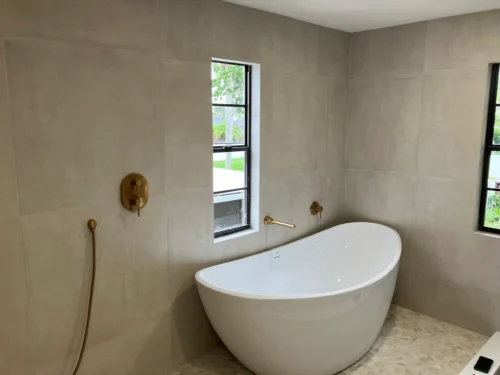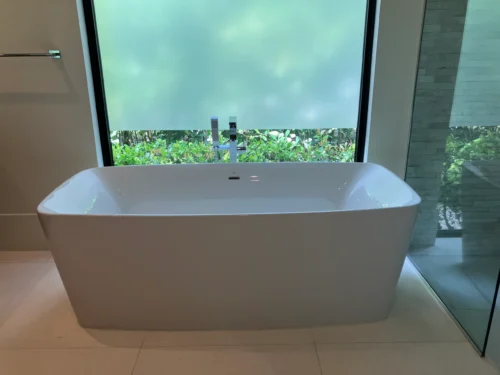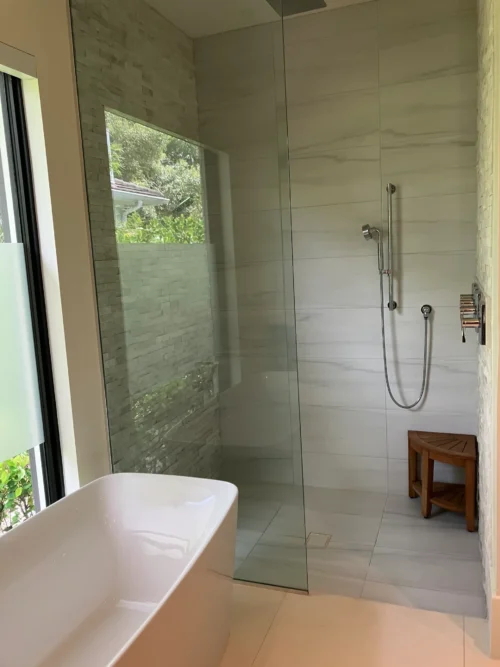Takeaways
- Bathtub relocation improves layout efficiency but requires careful plumbing, structural, and code planning.
- Costs vary significantly based on foundation type, tub style, and fixture distance from existing plumbing.
- Professional plumbing ensures code compliance, leak-free results, and long-term value for remodel investments.
Understanding Bathtub Relocation
What It Means to Relocate a Bathtub
Moving a bathtub involves shifting the fixture and all plumbing to a new spot. This process reconfigures supply lines, drain pipes, and venting within the floor or walls. We also adjust framing to support weight and maintain waterproofing. Next, we coordinate with electricians and tile pros so every detail lines up. Because all systems connect, precise planning keeps costs predictable and performance reliable.
Why Homeowners Choose to Move a Bathtub
Homeowners move a tub to open floor space and improve daily comfort. Changing the tub’s location can create safer paths and better natural light. We often design layouts that accommodate walk-in showers or larger vanities. Because families grow, updated footprints help everyone share the room easily. These lifestyle benefits usually outweigh the extra plumbing expense when executed properly.
When Is It Worth the Effort and Cost?
Value emerges when layout changes eliminate crowding and boost property appeal. We assess return by comparing relocation costs with resale gains and daily usability. If plumbing runs stay near wet walls, project costs remain manageable. Also, replacing aging lines during relocation prevents future leaks and service calls. When these factors align, moving the tub becomes a smart, strategic upgrade.
Plumbing Complexity Behind the Scenes
Rerouting Drain Lines and Vents
Drain lines require continuous slope, so we calculate every fraction of an inch during planning. Next, we route vents to balance pressures, preventing gurgles and safeguarding trap seals consistently. Because joists intersect paths, we notch carefully or add sleeves, maintaining structural strength throughout. We hang pipes with resilient straps that dampen vibration and hush flowing water. Inspectors appreciate clear diagrams we provide, which streamline approvals and reduce costly delays.
Hot and Cold Supply Line Adjustments
Supply lines deliver comfort, so we route them with minimal bends and secure anchor points. We favor PEX tubing because flexibility trims fittings, reducing leak risks and installation hours. Also, we insulate hot lines to preserve temperature and prevent scald shock at faucets. Balanced pipe diameters keep pressure even when multiple fixtures run simultaneously. Finally, we pressure-test assemblies before walls close, giving homeowners confidence and avoiding surprises.
Code Compliance and Permitting Requirements
Local codes safeguard health, so we integrate them into drawings before touching any pipe. We pull permits early, allowing inspectors to guide revisions rather than flagging completed work. Next, we schedule rough-in and final inspections in sync with framing and finish milestones. Because accurate documentation speeds closings, we photograph hidden piping and share digital records with owners. Passing every step preserves property value and aligns with the International Plumbing Code.
Structural Challenges That Often Arise

Subfloor Reinforcement and Joist Modifications
Heavy tubs concentrate loads, so we reinforce joists before plumbing crews set the new drain. We sister lumber or add engineered beams when spans exceed manufacturer deflection guidelines. Also, we apply waterproof underlayment on strengthened decks, preventing moisture damage under tile. Blocking around drain boxes stabilizes subfloors and quiets creaks that annoy homeowners. This engineered approach protects both finish materials and long-term structural health.
Load Considerations for Heavy Tubs
Cast-iron models weigh over four hundred pounds before water, demanding thoughtful support design. We calculate combined live and dead loads using standard building references and engineering tables. Next, we distribute weight with double headers and steel hangers at cut joist areas. Because movement ruins grout, we secure framing tightly to stop flex beneath tile. The result delivers silent baths and eliminates cracking corners down the road.
Accessing Plumbing in Slab vs. Raised Foundations
Raised floors simplify pipe rerouting because crawlspace access keeps dust outside living areas. Slab homes require concrete cutting, so we employ saws with vacuums and plastic barriers. Also, we pour new concrete after placing sleeves, restoring slab integrity and supporting finished flooring. Hidden utilities such as radiant heat loops influence routing decisions during slab projects. We explain these differences early, helping homeowners choose realistic timelines and budgets.
Comparison of Tub Relocation Methods
Here’s a side-by-side comparison of raised-floor vs slab-cut approaches for bathtub relocation to aid homeowners in planning.
| Aspect | Raised Floor Method | Slab-Cut Method |
|---|---|---|
| Cost Impact | Moderate — new subfloor materials and blocking needed | Higher — concrete cutting, disposal and slab repair |
| Disruption Level | Lower — work confined under raised deck | Higher — dust, noise and drywall removal typical |
| Installation Time | Often 1–2 extra days for framing and leveling | Additional 2–3 days for cutting, backfill, curing |
| Future Access | Easier to add access panels under floor | Limited access unless rebuilt or chases added |
Cost Factors That Influence Your Budget
Plumbing Labor and Material Costs
Labor usually represents the largest slice of any bathtub relocation budget we draft. Complex runs through joists or slabs increase hours, while simple reroutes finish faster. We choose materials jointly with clients, balancing upfront cost against durability and warranty length. Next, we lock pricing before ordering, shielding homeowners from mid-project supplier increases. Transparent line items foster trust and simplify future maintenance planning.
Demolition, Debris Removal, and Disposal Fees
Demolition starts with dust control barriers that protect nearby rooms and HVAC returns. We remove fixtures carefully to avoid collateral damage, then load debris into secure bins. Cast-iron tubs weigh plenty, so disposal fees climb due to landfill weight limits. Also, recycling steel or porcelain parts sometimes offsets disposal costs when facilities accept them. Advance budgeting for these logistics prevents sticker shock once demolition completes.
Finishing Costs: Surrounds, Tile, Drywall, Paint
Finishes define the visual impact, so we allocate sufficient funds for quality materials. Large format tiles reduce grout lines yet demand flatter substrates, sometimes increasing prep labor. We suggest mildew-resistant drywall and primers to maintain healthy indoor air long term. Paint color influences perceived space, with lighter hues amplifying sunlight from new window placements. Our designers guide choices that marry durability with style, ensuring satisfaction years later.
Unexpected Expenses Homeowners Often Miss
Water damage hides beneath old tubs and often reveals rotten subfloors needing replacement. We sometimes discover outdated electrical branch circuits too close to wet areas, requiring updates. Galvanized pipes corrode internally, so upsizing becomes essential when we uncover restricted flow. Permit revisions can introduce extra municipal fees if plans change midstream. A prudent contingency fund cushions these surprises, allowing work to progress smoothly.
Tub Type Considerations in a Relocation Project

Freestanding vs. Alcove Tubs
Freestanding tubs showcase sculptural beauty but occupy more floor area than alcove models. Alcove installations maximize storage because walls can host niches and showerheads above. We discuss cleaning routines since freestanding units expose every side for mopping access. Drain placement differs, with freestanding traps centered, while alcove drains hug wall studs. These distinctions guide clients toward styles aligning with space, budget, and maintenance preferences.
Cast Iron, Acrylic, or Fiberglass – What Matters Structurally
Cast-iron tubs boast longevity yet challenge installers with weight and handling complexity. Acrylic options weigh less and offer modern shapes with smooth finishes. Fiberglass models provide affordability, though surfaces may scratch more easily. We match material choices with floor strength and homeowner maintenance preferences. Informing clients clearly prevents disappointment and fosters confident decision making.
Weight, Drain Placement, and Floor Footprint Impacts
Drain outlets vary by brand, so we verify joist clearance before final purchasing. Footprint size dictates how much flooring we patch or replace during installation. We distribute weight across blocking to prevent sagging and tile cracks later. Also, we align overflow heights with wall niches, ensuring ergonomic reach while bathing. These micro measurements guarantee comfort and long-lasting finishes throughout the remodel.
Planning the Layout and Working With Wet Walls
The Importance of Proximity to Existing Plumbing
Short pipe runs waste less water while delivering hot flows more quickly. We map existing lines with cameras, then overlay proposed routes for comparison. Keeping near wet walls lowers labor costs and speeds inspections significantly. Also, shorter runs maintain pressure equilibrium between fixtures, improving overall experience. We share these savings upfront, empowering homeowners to balance design dreams with budgets.
Working Around Load-Bearing Walls and Obstacles
Load-bearing walls restrict drilling, so we reroute pipes under floors or above ceilings. Carpenters install double headers when openings become unavoidable for vent paths. We also coordinate with electricians to avoid overlapping cavities that complicate inspections. Ducts, wiring, and HVAC boots influence decisions, so collaboration prevents conflicts. Advance planning saves time, money, and stress for everyone involved in the project.
Optimizing Space in Small Bathrooms Without Sacrificing Code
Tight bathrooms demand clever fixtures such as corner tubs or sliding shower screens. We model clearances in software, confirming code distances for knees, doors, and faucets. In many cases, moving the tub diagonally unlocks valuable walkway and storage space. Also, wall-hung vanities create floor visibility, making compact rooms feel brighter and larger. Smart design maximizes comfort without triggering permit red flags during inspection.
DIY vs Professional Bathtub Relocation

What a Skilled DIYer Can (and Shouldn’t) Attempt
Experienced DIYers handle demolition neatly, protecting remaining finishes with plastic and drop cloths. They also manage light framing repairs when no structural elements require engineering. Running new drains, vents, and pressure lines moves beyond typical homeowner expertise. We recommend calling professionals for any work concealed behind waterproof surfaces. Doing so prevents leaks, mold, and costly reconstruction after failed inspections.
Why Most Projects Require a Licensed Plumber
Licensed plumbers understand code requirements and employ tools that guarantee watertight joints quickly. We carry bonding and insurance, which safeguard homeowners from accidental property damage. Our experience accelerates troubleshooting when unexpected obstructions appear within walls or slabs. Also, inspectors trust documented procedures we follow, expediting approval and reducing project downtime. Choosing professionals ultimately saves money through fewer delays and lasting craftsmanship.
When a General Contractor Is Also Needed
Large remodels involve electricians, tilers, and painters whose schedules intertwine tightly. Remodel plumbing coordination becomes essential when multiple trades work in one confined area. We collaborate with contractors, providing plumbing milestones that keep bigger projects moving smoothly. Also, contractors handle permit bundles for structural, electrical, and plumbing scopes simultaneously. This partnership frees homeowners from daily coordination tasks and streamlines communication channels.
FAQs About Bathtub Relocation
How long does a typical bathtub relocation project take?
Timeline depends on foundation type, tile complexity, and local inspection availability. We finish straightforward raised-floor relocations with standard finishes in roughly two working weeks. Slab homes and intricate mosaics extend duration to three or four weeks. Also, holidays or special-order materials can lengthen schedules, so we communicate updates early. Clear milestones keep everyone aligned and minimize inconvenient surprises for residents.
Can a tub be relocated without tearing up the floor?
Raised foundations often allow plumbers to reroute pipes from below, preserving finished flooring. We access joist bays through crawlspace openings, leaving surface materials untouched above. Slab houses typically demand concrete trenching around the new drain location. We minimize dust with saws equipped with vacuums and by sealing adjacent rooms. Every project receives a custom approach after evaluating structure, plumbing paths, and finishes.
Is it possible to keep my current tub when moving it?
Acrylic or fiberglass tubs usually detach intact, letting us reinstall them after relocation. We inspect flanges, drain threads, and underlying surfaces for cracks before approving reuse. Cast-iron tubs demand lifting gear yet often survive moves without damage. Many clients choose refinishing after relocation, giving the old fixture a fresh look. Keeping the original tub saves money and preserves design continuity within the remodel.
Do I need to update my water heater if I move the tub farther away?
Longer pipe runs sometimes cool water, causing noticeable delays at the faucet. We evaluate heater capacity, line diameter, and insulation before recommending upgrades. Water heater recirculation pumps or larger pipes often solve delivery lag without full replacement. When the existing unit nears end of life, combining upgrades saves future labor. Energy-efficient models also reduce utility costs, enhancing the remodel’s overall value.
3 Practical Tips for a Smooth Bathtub Relocation
Design Around Plumbing, Not Just Aesthetics
Early design coordination shortens pipe runs and maintains strong water pressure at fixtures. We verify drain heights before framing, avoiding last-minute floor or joist adjustments. Clients enjoy smoother schedules because suppliers receive accurate dimensions from day one. Also, smart alignment conserves energy by reducing hot water travel distance. Function and form coexist beautifully when plumbing drives decisions alongside aesthetics.
Get Multiple Bids With Itemized Line Items
Competitive bids reveal pricing variations and highlight scope differences among contractors. We encourage homeowners to compare warranties, timelines, and material brands before choosing. Itemized proposals prevent disputes because each party understands responsibilities clearly. Also, line items simplify future maintenance budgeting by breaking down material and labor. Transparent communication lays foundation for trust and smoother collaboration during construction.
Always Budget 20% for Hidden Surprises
Hidden water damage, outdated wiring, or incorrect framing can surface once walls open. We advise allocating twenty percent of the project cost for unforeseen issues. This cushion permits quick fixes without stressful financial scrambling mid-project. Unused contingency funds can enhance finishes or remain in savings after completion. Prepared budgets keep morale high and schedules intact despite unexpected discoveries.
Post-Relocation Finishing Work
Waterproofing and Tile Installation
Waterproofing membranes form the primary defense against leaks behind decorative tile. We overlap seams carefully, following manufacturer guidelines for corners and penetrations. Next, we set tiles with premium thin-set, ensuring full coverage under every edge. We then grout joints tightly, yielding clean lines that resist staining. Careful curing delivers surfaces that endure daily steamy conditions without deterioration.
Choosing Fixtures and Surrounds That Fit the New Layout
Plumbing fixtures influence comfort, water efficiency, and long-term maintenance demands. We propose low-flow valves and handheld shower wands that enhance accessibility. Acrylic surrounds install quickly, whereas custom tile offers limitless pattern opportunities. Also, integrated lighting rings around niches brighten bathing areas and boost safety. These thoughtful choices bring everyday joy and reduce cleaning chores significantly.
Final Inspection and Leak Testing Before Sign-Off
Pressure tests verify every joint, union, and valve before walls receive paint. We document readings digitally, sharing reports with homeowners and municipal inspectors immediately. Next, we run the tub through multiple fill and drain cycles, monitoring flow. Our team fixes any drip on the spot, preventing future frustration. Signed approvals close permits and officially complete the relocation project.
How Bathtub Relocation Fits Into a Larger Remodel
Coordinating With Vanity, Toilet, and Shower Moves
Relocating a tub often triggers adjustments for vanity, toilet, and shower positions. We craft holistic layouts, ensuring balanced sightlines and comfortable traffic flow between fixtures. Shared wet walls reduce costs when multiple elements move together inside one project. Also, simultaneous work prevents piecemeal demolition that prolongs overall renovation duration. Integrated planning delivers cohesive aesthetics and streamlined plumbing runs behind surfaces.
Planning the Sequence of Work to Avoid Delays
Sequencing sets momentum, so we schedule demolition, framing, rough plumbing, and inspections logically. Finish crews like tile setters enter only after waterproofing cures fully, preventing bond failure. Also, ordering long-lead fixtures early avoids waiting weeks for backordered valves or trims. We share calendars with all trades, encouraging accountability and proactive conflict resolution. Smooth sequencing protects budgets and shortens time homeowners spend living among construction.
When It Makes Sense to Reconfigure the Entire Bathroom
Major plumbing moves present a prime opportunity to rethink overall bathroom function. We consider aging-in-place needs, storage deficits, and lighting shortcomings during planning. Combining upgrades under one permit saves fees and reduces cumulative household disruption. Also, unified design ensures finishes match, avoiding patchwork aesthetics common with staggered projects. Strategic reconfiguration boosts resale appeal and daily joy for current occupants.
Beyond the Pipework – Total Value of a Smart Relocation
Boosting Long-Term Resale Value With Better Layouts
Buyers love bathrooms that feel spacious, modern, and thoughtfully arranged. We relocate tubs strategically, creating visual width that photographs beautifully for listings. Appraisers note quality plumbing updates, often reflecting them in higher valuations. Also, energy-efficient fixtures attract eco-minded buyers seeking lower utility bills. These combined benefits often recover investment when homeowners eventually sell.
Improving Accessibility and Comfort
Relocation enables ergonomic heights, grab bars, and wider entries without structural compromises. We recommend slip-resistant flooring and easily reached controls for family members with mobility challenges. Thoughtful lighting angles reduce shadows and improve safety during evening baths. Also, quiet fill valves enhance relaxation by lowering background noise. Comfort upgrades deliver daily satisfaction long after construction dust settles.
Avoiding Regret With Clear Upfront Planning
Changes cost least on paper, so we encourage extensive design discussions early. We provide 3D renderings that show clearances, lighting, and finished elevations accurately. Clients visualize toothbrush holders and towel bars, preventing awkward discoveries later. Also, detailed specs lock orders, reducing shipment errors and